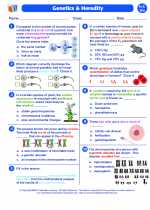Transgenic Organisms
Transgenic organisms are organisms that have had foreign DNA inserted into their genetic material. This process is typically carried out in the field of genetics and biotechnology, and it has a wide range of applications in agriculture, medicine, and research.
Process of Creating Transgenic Organisms
The process of creating transgenic organisms involves several key steps:
- Isolation of the gene: The gene of interest is identified and isolated from the donor organism.
- Insertion of the gene: The isolated gene is inserted into the genome of the recipient organism using techniques such as gene guns, microinjection, or viral vectors.
- Selection and breeding: Transgenic organisms that have successfully incorporated the foreign gene are identified and bred to create a stable transgenic line.
Applications of Transgenic Organisms
Transgenic organisms have a wide range of applications, including:
- Agriculture: Transgenic plants can be engineered to be resistant to pests, diseases, and herbicides, as well as to have improved nutritional profiles.
- Medicine: Transgenic animals are used in medical research to study human diseases and to produce therapeutic proteins and drugs.
- Research: Transgenic organisms are valuable tools for studying gene function and regulation, as well as for understanding complex biological processes.
Ethical and Environmental Considerations
The use of transgenic organisms raises ethical and environmental concerns, including the potential impact on biodiversity, the spread of transgenes to wild populations, and the safety of genetically modified organisms for human consumption.
Study Guide
- Define transgenic organisms and explain the process of creating them.
- Discuss the applications of transgenic organisms in agriculture, medicine, and research.
- Evaluate the ethical and environmental considerations associated with the use of transgenic organisms.
- Compare and contrast the benefits and concerns related to transgenic organisms in different fields of application.
- Propose potential regulations or guidelines to address the ethical and environmental concerns associated with transgenic organisms.
◂Biology Worksheets and Study Guides High School. Genetics and heredity I
Worksheet/Answer key Genetics and heredity I
Genetics and heredity I  Worksheet/Answer key
Worksheet/Answer key Genetics and heredity I
Genetics and heredity I  Worksheet/Answer key
Worksheet/Answer key Genetics and heredity I
Genetics and heredity I  Worksheet/Answer key
Worksheet/Answer key Genetics and heredity I
Genetics and heredity I  Vocabulary/Answer key
Vocabulary/Answer key Genetics and heredity I
Genetics and heredity I  Vocabulary/Answer key
Vocabulary/Answer key Genetics and heredity I
Genetics and heredity I  Vocabulary/Answer key
Vocabulary/Answer key Genetics and heredity I
Genetics and heredity I  Vocabulary/Answer key
Vocabulary/Answer key Genetics and heredity I
Genetics and heredity I  Vocabulary/Answer key
Vocabulary/Answer key Genetics and heredity I
Genetics and heredity I  Vocabulary/Answer key
Vocabulary/Answer key Genetics and heredity I
Genetics and heredity I  Vocabulary/Answer key
Vocabulary/Answer key Genetics and heredity I
Genetics and heredity I 

 Worksheet/Answer key
Worksheet/Answer key
 Worksheet/Answer key
Worksheet/Answer key
 Worksheet/Answer key
Worksheet/Answer key
 Vocabulary/Answer key
Vocabulary/Answer key
 Vocabulary/Answer key
Vocabulary/Answer key
 Vocabulary/Answer key
Vocabulary/Answer key
 Vocabulary/Answer key
Vocabulary/Answer key
 Vocabulary/Answer key
Vocabulary/Answer key
 Vocabulary/Answer key
Vocabulary/Answer key
 Vocabulary/Answer key
Vocabulary/Answer key

The resources above cover the following skills:
LIFE SCIENCE (NGSS)
Heredity: Inheritance and Variation of Traits
Students who demonstrate understanding can:
Ask questions to clarify relationships about the role of DNA and chromosomes in coding the instructions for characteristic traits passed from parents to offspring.
Apply concepts of statistics and probability to explain the variation and distribution of expressed traits in a population.